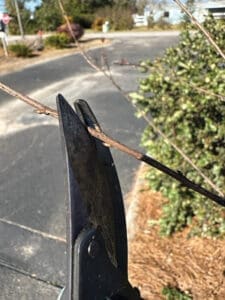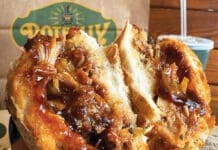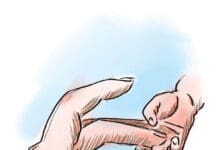 By Julie McConnell, UF/IFAS Extension
By Julie McConnell, UF/IFAS Extension
Pruning is one of those landscape maintenance projects that sounds simple but is often done incorrectly. Timing and pruning technique is as important as the tools you use. I’m going to go over some basic tips for pruning flowering shrubs this month.
Why prune?
The first question you should ask yourself is why am I pruning? Valid reasons for pruning shrubs include removing diseased/damaged/dead branches, increasing airflow or sunlight within the canopy, improving the shape, or reducing size. Keep in mind, the repeated need to reduce the size of a plant can be eliminated by selecting the Right Plant for the Right Place, but that’s another topic!
 When should you prune flowering shrubs?
When should you prune flowering shrubs?
The answer to this question really depends on which type of growth the flower buds are formed on – current or previous season growth. Pruning at the wrong time of year can significantly reduce flowering. A general rule of thumb to use when predicting the ideal time to prune flowering shrubs is called the May Rule. If a plant flowers before May 1, it is most likely flowering on the previous season’s growth and should be pruned after it blooms. If the plant flowers after May 1, it is likely blooming on the current season’s growth and can be pruned during the winter or early spring.
The following plants do not necessarily need to be pruned, however, if they do this is the recommended timing.
Examples of shrubs that flower before May 1 and should not be pruned until after they flower include azaleas, spirea, mophead hydrangeas, camellia, and Indian hawthorne.
Examples of flowering shrubs that bloom on the current season’s growth and can be pruned in the winter/early spring include roses, hibiscus, abelia, butterfly bush, oleander, plumbago, and bottlebrush.
How to make a proper pruning cut?
The most common cut is called a heading cut. Heading cuts can be used to strategically shape a shrub if done properly. A heading cut takes off the terminal bud of a branch (the one at the tip) which contains hormones that prevent growth from lateral (side) buds along the stem. Removal of the terminal bud will stimulate new growth from lateral buds, typically within 6 inches of where the cut was made. Take the time to look at the plant and determine which direction you want new shoots to emerge – is there a gap in the shrub that needs to be filled in? is the interior too dense and more growth needed on the outside? Step back and look at the shrub periodically to make sure you are training the plant to grow in the desired direction. Use sharp, clean pruners to make an angled cut just above the bud where you want to stimulate new growth.
Mistakes to avoid.
Topping or hedging. Repeatedly hedging shrubs stimulates new growth at the top which shades out the bottom of the plant. This results in a “top-heavy” appearance with little to no foliage at the base.
Using dull pruners. Dull tools can cause crushing injury to stems which increases moisture loss and susceptibility to disease, insects, and decay. Be sure tools are sharp and the appropriate size for the branch diameter to be cut.
Not sanitizing tools. To prevent the spread of disease, clean pruning tools with a 10% bleach solution between cuts. Bleach can be corrosive to tools, so be sure to oil before storing.
For specific questions about pruning or other landscape care visit Ask IFAS at https://edis.ifas.ufl.edu.
An Equal Opportunity Institution. UF/IFAS Extension, University of Florida, Institute of Food and Agricultural Sciences, Andra Johnson, Dean. Single copies of UF/IFAS Extension publications (excluding 4-H and youth publications) are available free to Florida residents from county UF/IFAS Extension offices.





















































